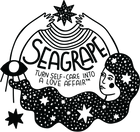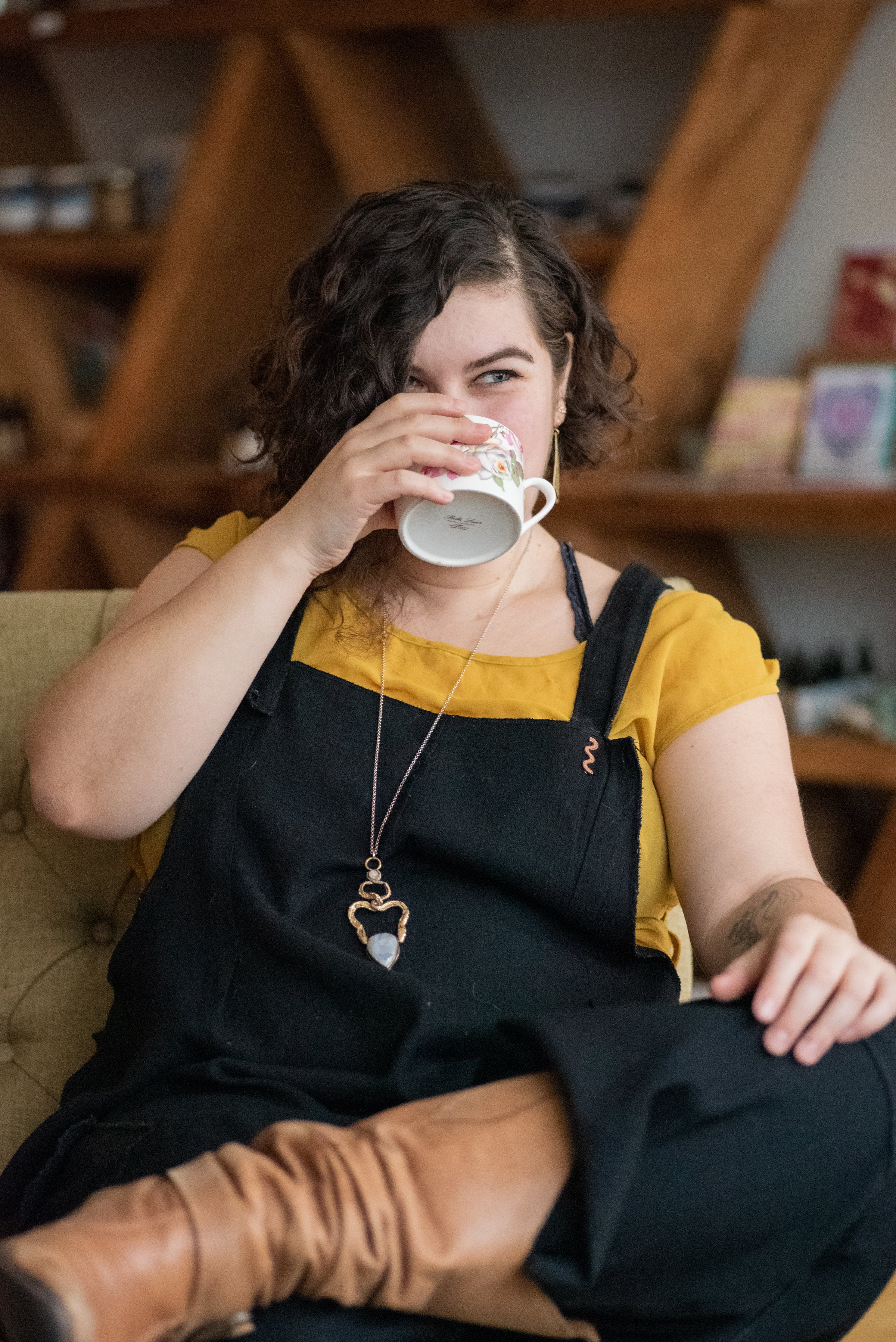Fortune Telling and Roma Futurism: Guest Blog Post Jezmina Von Thiele
My Sinti grandmother began teaching me palm reading when I was five years old in her little trailer decorated with dark wooden ornaments brought over from Germany. “You will always need a trade to fall back on,” she told me. “With this, you can work anywhere.” She was teaching me the very heart of fortune telling within culture: survival.
Sinti are a subgroup of Roma, an ethnic group more commonly known by the racial slur “Gypsies.” You may hear Roma sometimes refer to themselves as Gypsies, and it is our right to reclaim that word amongst ourselves, as many ethnic groups have reclaimed racial slurs. And like any other racial slur, it is not ok for non-Roma (gadje) to appropriate or use “Gypsy,” or its relative, “gypped.” Roma are part of the Indian diaspora, leaving the northwest of India around the 10th century and traveling west, likely because of the long war between Muslims and Hindus at that time. There is evidence to suggest that the first Roma comprised the army defending Hindu territory, an ethnic mix of low-caste Indians and African migrants. When the early Roma moved west, they took their families, culture, trades, and beliefs with them. One of those trades was fortune telling, particularly, palmistry.
Roma needed trades like fortune telling, performance, manual labor, and craftsmanship that they could practice anywhere to survive. On their journeys, Roma encountered intense prejudice and violence, particularly in Europe around the 1300s and 1400s. Roma were persecuted for their beliefs, language, and skin color; they were enslaved in the Balkans; they were chased out of towns; and they were hunted like animals. Many of the racist laws and stereotypes used to control and oppress Roma still plague us today. In the 20th century, nearly half of Europe’s Roma and Sinti were murdered in the Holocaust. Today, Roma experience disproportionate levels of poverty, particularly in Europe. Roma also face continued threats from fascist parties, police brutality, human trafficking, hate crimes, segregation, and inadequate housing, education, healthcare, and employment opportunities. They romantic dream of the carefree and wandering Roma is a story told by the oppressors to hide the fact that Roma were persecuted into nomadism centuries ago. Trades that Roma can practice on the road became essential. Fortune telling can be practiced anywhere with little to no materials, and became very popular for Romani women trying to support their families in particular. Since Roma women have been historically demonized and exoticized for our ‘magic, non-Roma would seek them out for advice, charms, cures, and curses.
Some Roma who tell fortunes see it simply as a job. Some see it as a spiritual practice. My family is somewhere in the middle. Similar to First Nations people, there are many different Romani groups (or vitsas), all with distinct practices and dialects. It’s impossible to generalize about us as a culture, and of course, beyond that, we are all individuals with our own experiences that shape the way we relate to and express our heritage. Different vitas often are known for different trades. The Kalderash, for instance, are renowned for their beautiful metal work, and the Kale famously created Flamenco music and dance. Then within those groups, certain families may be known for particular trades or skills. The women in my family were known for their dancing, as well as their palmistry, card reading, and tea leaf reading. Some worked with herbs, prayer, and ritual to support their community’s spiritual and physical health, or as we conceptualize it, our ‘purity.’ Later, my grandmother styled herself as a horse trainer after fleeing to the US from Germany, shortly after the devastation of her family, community, and culture in WWII. It allowed her to hide in and adapt to her new life as an immigrant, as it was not safe to openly be Sinti or Romani anywhere. Outside of this, many Roma work different professions that have nothing to do with trade work. We are lawyers, medical professionals, educators, public servants, artists, and more. The more access Roma have to education and employment opportunities like everyone else, the more we do. In addition to my trade work, I’m a writer and an educator, and I’ve taught a range of topics from college classes in global literature to middle school history.
My family wanted me to pursue an education as well as our trades. As it turns out, unlike the rest of my family, I am a terrible horseback rider. So, my grandmother, mother, and aunt all made sure that I became adept at fortune telling and dancing from a young age. They wanted to keep me in a job no matter what, and to keep our culture alive, which is a struggle as a mixed and assimilated Sinti family in the US, living far away from our surviving Sinti family, and far from any other Romani community. It was lucky for me, because learning these trades are among my happiest memories. I prayed to my ancestors and to Sara la Kali, listened to my grandmother’s stories, and practiced with her every weekend. Reading my grandmother’s palm, tea leaves, and cards every week as a little girl taught me nearly everything I’ve needed to know, because through my training, I learned about her incredible life and all the she survived. My grandmother also taught me the more family-bound practices meant to heal and protect the community, which is another important aspect for her resilience.
While this may sound mystical to an outside ear, Romani communities are not at all magical in the way that outsiders assume. If we had magical powers, trust me, we would have eradicated Fascism for y’all ages ago. Some Roma, however, do connect with the idea of magic and witchcraft, although it is very complicated in our community, and sometimes frowned upon for religious reasons and for fear of promoting harmful stereotypes. Romani actress, activist, and writer Mihaela Drâgan coined the term Roma Futurism, heavily inspired by AfroFuturism, to place Roma firmly in the future, in relationship with technology and with magic. She works with self-proclaimed Romani witches, and with technology, to curse Fascist politicians in her home country, Romania, and elsewhere in the world. They also cast spells to enlighten politicians to resist corruption and protect human rights. Drâgan also founded Giuvlipen, a Romani feminist theatre troupe that writes and performs incredible shows rooted in Romani experiences and issues. Witchcraft and magic in the new Roma Futurism movement is largely performance art, but at the same time it is rooted in some of the cultural practices of Roma, as well as the divinatory and spiritual practices of the fringe, self-proclaimed witches within the Romani community. The witchcraft of Roma Futurism, first and foremost, is a tool for liberation, empowerment, and visibility.
A child of the 90’s, soaking up The Craft and Sabrina the Teenage Witch, and coming from the type of Sinti family that I do, it’s no wonder that I’ve embraced the word ‘witch.’ I am tentative about it though because as a Romani person, it is so often misunderstood. There is a good deal of Romani spirituality that I will never share with non-Roma because it is sacred, and there are plenty of stories and practices my grandmother taught me that are just for our family. There are other parts that I can share, and I’m happy to teach about the beauty and richness of a culture I love, full of glamour and resilience. There are aspects of fortune telling for me that are all business, and other parts that are deeply profound. I’m happy to share this too, with the caveat that other Roma will practice these trades differently, so my experience is just one sliver of light through a stained-glass window. In allegiance with Roma Futurism, I use writing, art, performance, social media, witchcraft, and technology to connect communities, fight fascism, heal others, and nurture resilience, all of which blends together in its own form of magic.
I encourage you to learn more about Romani culture from the Romani people themselves. RomArchive is a wonderful resource for Romani arts, academics, and Holocaust survival stories. There are also education organizations like The Roma People’s Project at Columbia University. You can learn a lot by following Romani people on social media and reading what they post. Personally, I think one of the best ways to learn about a culture is to consume and share their art, music, and stories. Creativity, resistance, and resilience have always been our true powers.
---
Jezmina Von Thiele is a Brooklyn-based fortune teller who reads tarot, tea leaves, and palms in her mother's Sinti-Romani tradition. She is an activist, educator, writer, and artist who loves to support the fight for Roma rights world-wide, and to share the diverse beauty of Romani culture.
Want to dive even deeper with magical practices and an amazing community? We invite you to join our private Seagrape Babes online network! Engage with a gorgeous community of magical beings, get early access to spells and videos, and enjoy exclusive access to bonus monthly material. To learn more click here.
Show more







+Leave a comment